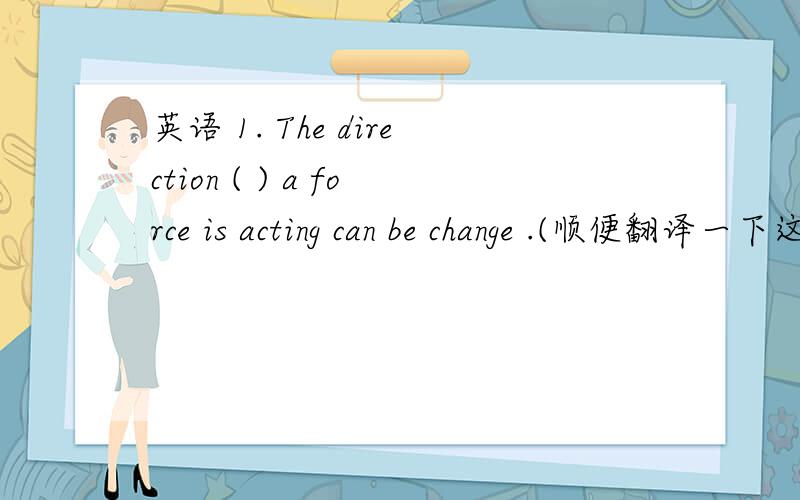英语 1. The direction ( ) a force is acting can be change .(顺便翻译一下这句) A. that B.which C. fr英语 1. The direction ( ) a force is acting can be change .(顺便翻译一下这句)A. that B.which C. from which D. wher
来源:学生作业帮助网 编辑:作业帮 时间:2024/04/28 06:59:12

英语 1. The direction ( ) a force is acting can be change .(顺便翻译一下这句) A. that B.which C. fr英语 1. The direction ( ) a force is acting can be change .(顺便翻译一下这句)A. that B.which C. from which D. wher
英语 1. The direction ( ) a force is acting can be change .(顺便翻译一下这句) A. that B.which C. fr
英语 1. The direction ( ) a force is acting can be change .(顺便翻译一下这句)
A. that B.which C. from which D. where
什么是同位语?这句是不是
2. ( ) came back first was supposed to win the first prize.
是填No matter who 还是whoever?
还有什么事让步状语从句?
望高手解答,thanks.
英语 1. The direction ( ) a force is acting can be change .(顺便翻译一下这句) A. that B.which C. fr英语 1. The direction ( ) a force is acting can be change .(顺便翻译一下这句)A. that B.which C. from which D. wher
1:D,Direction 是地点,修饰地点用where,这句不是同位句,同位句一般用that链接,
翻译:发生暴力的那个地方已经变了.
2:填 whoever
whoever 既可引导名词性从句(主语从句,宾语从句,表语从句),
也可引导让步状语从句,no matter who 只能引导状语,不能引导名词性从句.
即,引导让步状语可互换,引导名词性从句不能互换.
第一题选D。这句话的意思是发生暴力的地方已经变了。
一个名词(或其它形式)对另一个名词或代词进行修饰,限定或说明,这个名词(或其它形式)就是同位语。同位语与被它限定的词的格要一致,并常常紧挨在一起。when,where,why引导的定语从句的先行词一定分别是表示时间、地点和原因的名词,而三者引导的同位语从句的先行词则肯定不是表示时间、地点和原因的名词。所以这个应该不是同位语,而是定语从句。...
全部展开
第一题选D。这句话的意思是发生暴力的地方已经变了。
一个名词(或其它形式)对另一个名词或代词进行修饰,限定或说明,这个名词(或其它形式)就是同位语。同位语与被它限定的词的格要一致,并常常紧挨在一起。when,where,why引导的定语从句的先行词一定分别是表示时间、地点和原因的名词,而三者引导的同位语从句的先行词则肯定不是表示时间、地点和原因的名词。所以这个应该不是同位语,而是定语从句。
顺便补充下,when,where,why引导定语从句时,它们叫做关系副词,在从句中充当状语,可以转换成"介词+关系代词"的形式;引导同位语从句时,它们叫做连接副词,在从句中充当状语,但不能转换成"介词+关系代词"的形式。
如:1。This is the house where I lived two years ago.
2。He put forward to the question where the meeting would be held.
第一句是定语从句,where在从句中作状语,它可以转换成in which的形式。
第二句是是同位语从句, where在从句中充当状语,但不能转换成"介词+关系代词"的形式。
第二题选whoever。让步状语从句是状语从句中的一种,其本身也是状语从句。一般翻译为“尽管……即使……”就是我们日常生活中用的“退一步说……”的感觉。
“no matter+疑问词”或“疑问词-ever”的含义为“……都……;不管……都……” 它们引导的让步状语从句可以互换。但“no matter+疑问词”结构只能引导让步状语从句,而“疑问词-ever”还可以引导名词性从句。例如: Whoever comes will be welcome. (Whoever 引导主语从句) 不管谁来都受到欢迎。 这个和你的题目应该是一样的道理,都是引导状语从句,说明这一句不是让步状语从句。
好了,希望对你有帮助哦。。
收起
第一题:一种力量正在行动的方向能是改变。(有点别扭,不过字典上是这么写的)选D
第二题填No matter who
让步状语从句
1、Although he is old,he works very hard.
2、as
(1)Hard as he works,he makes little progress.
(2)Clever as I am,I...
全部展开
第一题:一种力量正在行动的方向能是改变。(有点别扭,不过字典上是这么写的)选D
第二题填No matter who
让步状语从句
1、Although he is old,he works very hard.
2、as
(1)Hard as he works,he makes little progress.
(2)Clever as I am,I didn't pass the exam.
3、even if
Even if he isn't clever,he finishes the work at last.
4、Whether he believe or not,it's ture.
No matter what happened,I would suppost you.
以上是我上课时记的笔记,记录的是让步状语从句中四组词,每句话的前半句都做出了让步,这就是让步状语从句。
收起